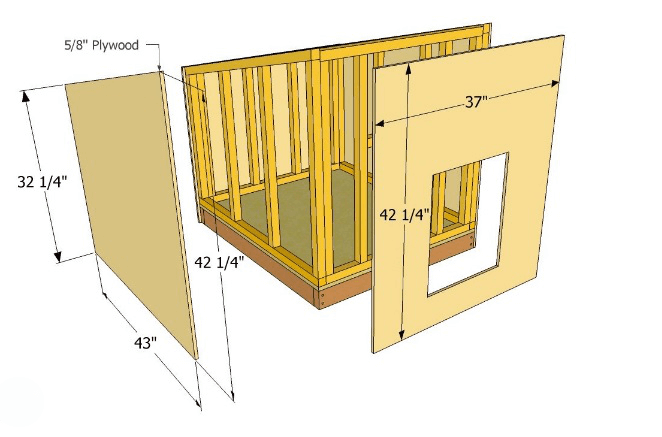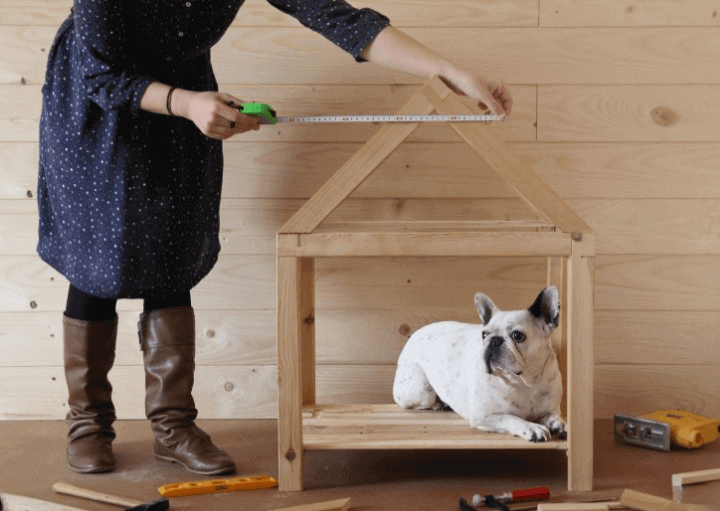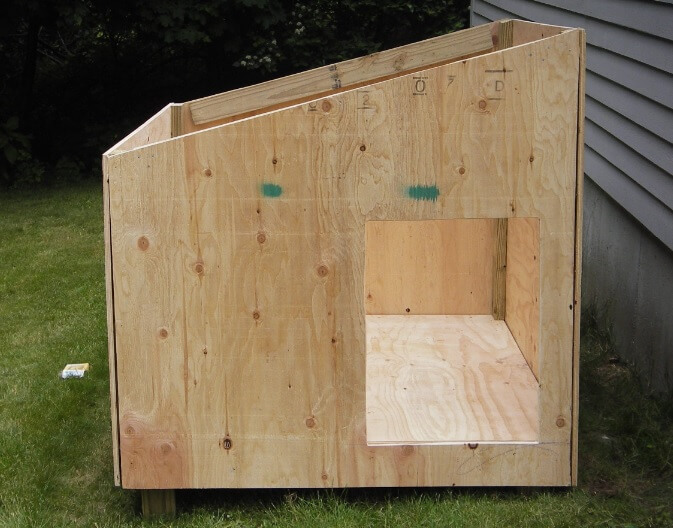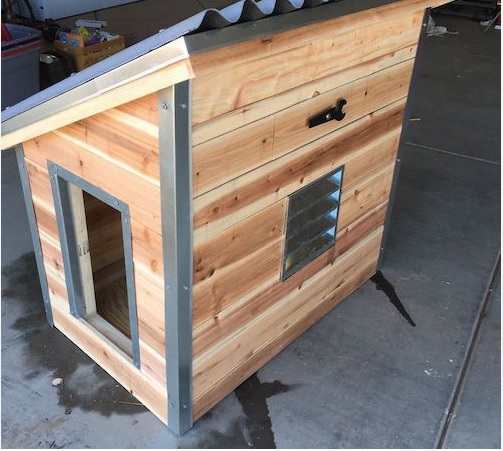In the realm of pet care, providing a suitable shelter for dogs is paramount to ensuring their well-being. Constructing a dog house offers an opportunity to create a safe and comfortable environment for our loyal companions.
This article aims to guide individuals in building a dog house by presenting a step-by-step approach that encompasses:
- Gathering necessary materials and tools
- Measuring and cutting wood
- Assembling the frame and walls
- Installing the roof and flooring
- Adding finishing touches to enhance coziness
By adhering to these directions, readers will be equipped with the knowledge required to construct a functional dog house that caters to their furry friends’ needs.
Key Takeaways
- Comfort and safety should be the top priorities when building a dog house.
- Incorporating DIY pet accessories can enhance the functionality and aesthetics of the dog house.
- Design considerations should include size, breed, insulation, ventilation, durability, and ease of maintenance.
- The dog house should provide a secure and comfortable space for the dog, with features such as raised floors, windows, shade, water dispenser, and proper drainage.
Gather the Necessary Materials and Tools
The required materials and tools for building a dog house include lumber, plywood, nails, screws, measuring tape, saw, drill, hammer, and paint.
When considering how to build a dog house, it is crucial to choose the right location in order to provide an optimal environment for the dog. The chosen area should be well-drained and elevated slightly off the ground to prevent water from seeping into the structure.

Furthermore, it is essential to protect the dog house from adverse weather conditions such as rain or extreme heat. To accomplish this, the roof should have a slight slope that facilitates water runoff and prevents accumulation on top of the structure. Additionally, installing an overhang can shield the entrance of the dog house from direct exposure to rain or sunlight.
Applying a coat of waterproof paint will further enhance its resistance against inclement weather. By carefully selecting an appropriate location and implementing measures to safeguard against weather conditions, one can ensure that their furry companion has a comfortable and secure shelter throughout all seasons.
Measure and Cut the Wood
To accurately construct a shelter for our canine companions, it is essential to meticulously measure and precisely cut the wooden materials. When choosing the right type of wood for your dog house, there are several factors to consider. Firstly, you should opt for a durable and weather-resistant wood such as cedar or pressure-treated lumber, as these materials can withstand outdoor conditions and prevent rotting or warping. Additionally, make sure the wood is free from any toxic chemicals or treatments that might harm your dog.

Once you have selected the appropriate wood, it is crucial to measure and mark the pieces accurately before cutting them. Start by measuring each side of the dog house carefully using a tape measure. Take into account any insulation or additional features you plan to add when determining the dimensions. After obtaining accurate measurements, use a pencil or chalk to mark the wood accordingly. For straight cuts, utilize a circular saw or table saw with a sharp blade for clean and precise edges.
Assemble the Frame and Walls
Assembling the frame and walls is akin to laying the foundation of a sturdy fortress, where each piece interlocks seamlessly to create a secure and reliable structure. This critical step requires precision and attention to detail in order to ensure the dog house is safe, comfortable, and aesthetically pleasing.
To start, gather all the necessary materials: wood panels, nails or screws, a hammer or drill, and a measuring tape. Begin by constructing the frame using four equal-sized pieces of lumber for each side. Connect them at right angles using nails or screws for added stability. Once the frame is complete, attach the floor panel securely using appropriate fasteners.

Next comes installing insulation to provide optimal comfort for your furry friend. Cut foam insulation panels according to the dimensions of each wall section and affix them with adhesive or staples. This will help regulate temperature inside the dog house during both hot summers and cold winters.
Once insulation is in place, it’s time to choose an appropriate paint color that not only enhances visual appeal but also protects the wood from weathering effects. Opt for pet-safe paint options that are non-toxic and durable. Apply multiple coats evenly over all surfaces, ensuring thorough coverage.
By following these guidelines when assembling the frame and walls of your dog house, you can create a solid foundation that will withstand time while providing utmost comfort for your beloved canine companion.
Install the Roof and Flooring
Once the frame and walls are securely in place, attention can be turned to installing the roof and flooring, which will complete the structure of this cozy shelter. When choosing the right roofing material for a dog house, it is crucial to consider durability and weather resistance. The roof should be able to withstand harsh elements such as rain, snow, and wind. Popular options include asphalt shingles or metal roofing sheets. Asphalt shingles provide good protection against moisture and are relatively easy to install. Metal roofing sheets offer excellent durability and are resistant to fire, rot, and pests.

In addition to selecting the appropriate roofing material, it is essential to insulate the dog house properly for the comfort of your furry friend. Insulation helps regulate temperature inside the structure by preventing heat loss during colder months and reducing heat gain in warmer seasons. One effective insulation method is using foam board insulation on both the roof and walls of the dog house. It provides excellent thermal resistance while being lightweight and easy to handle.
To further enhance insulation, ensure that all gaps or cracks are sealed with caulk or weather-stripping materials. This prevents drafts from entering the dog house while maintaining a comfortable environment for your pet.
By carefully choosing suitable roofing material and implementing proper insulation techniques, you can create a dog house that offers optimal protection from external elements while keeping your canine companion snug and secure throughout different seasons.
Add Finishing Touches and Make it Cozy
After completing the essential elements of the structure, attention can now be directed towards adding the final embellishments and creating a warm and inviting atmosphere within this charming haven. When it comes to interior design ideas for a dog house, there are several options to consider.
First and foremost, comfort should be prioritized. Placing a soft and cozy bed inside the dog house is essential for providing a relaxing space for our furry friends.
Additionally, incorporating DIY pet accessories can add both functionality and style to the interior. For instance, installing hooks on the walls can allow for easy storage of leashes or toys, keeping them organized and readily accessible.
Furthermore, adding decorative elements such as curtains or wall art can enhance the aesthetic appeal of the dog house while also reflecting the owner’s personal taste. However, it is important to ensure that these decorations are securely attached and do not pose any hazards to the dog.
See Also:
- Outdoor Dog Kennels: Ensuring Safety and Comfort
- Discover Gunner Kennels: Providing Unmatched Safety and Comfort for Your Canine Companion
- Retriever Dog Kennel
- Premium Ruffland Kennel: Elevate Your Dog’s Comfort and Security to New Heights
Conclusion
In conclusion, building a dog house requires gathering materials like sturdy wood and essential tools.
Precise measurements and precise cuts are needed to assemble the frame and walls securely.
Installing a strong roof and durable flooring ensures protection from the elements.
Adding cozy finishing touches creates a comfortable space for your furry friend.
By following these steps, you can construct a safe haven that gives your dog warmth, security, and shelter – a place they can truly call their own.
If you can’t find the right dog for you to adopt locally, please consider adopting a dog from Bone Voyage Dog Rescue. We’ll fly with your dog to you.
Frequently Asked Questions
How can I prevent my dog from chewing on the wood of the dog house?
To prevent dogs from chewing on the wood of a dog house, owners can provide appropriate chew toys and engage in training techniques that redirect their attention. These measures help discourage destructive behavior and promote positive habits.
Can I use treated lumber for building the dog house?
Using treated lumber for building a dog house has pros and cons. Pros include increased durability and resistance to decay, while cons include potential health risks due to chemical treatments. Alternatives to treated lumber can be explored, such as naturally rot-resistant woods or non-toxic sealants.
What type of insulation should I use to keep my dog warm in the winter?
Insulation options for a winter dog house include foam boards, reflective insulation, and straw. Foam boards provide excellent thermal resistance, while reflective insulation reflects heat back into the house. Straw is an affordable and natural option that provides good insulation.
Is it necessary to paint the dog house and what type of paint should I use?
Painting the dog house is not necessary, but it can provide additional protection and aesthetic appeal. If desired, use pet-safe exterior paint and apply multiple coats for durability. Consider alternative materials like sealants or stains for a natural look.
How do I ensure proper ventilation inside the dog house to prevent overheating?
Proper ventilation in a dog house is essential to prevent overheating. To achieve this, consider incorporating design elements such as windows, vents, or raised flooring. Additionally, using breathable and insulating materials like wood or insulated panels can optimize airflow while providing adequate insulation.
